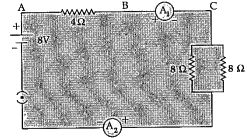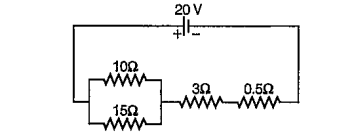If on applying the potential of 20V on a conductor its conductance becomes 8(Ω)−1, then the current flowing through it will be:
120A
160A
90A
80A
The correct Answer is:B
To find the current flowing through a conductor when a potential of 20V is applied and its conductance is given as 8Ω−1, we can follow these steps:
Step 1: Understand the relationship between voltage, current, and conductance
According to Ohm's Law, the relationship between voltage (V), current (I), and resistance (R) is given by:
V=I⋅R
However, we are given conductance (G), which is the reciprocal of resistance:
G=1R
Thus, we can express current in terms of voltage and conductance:
I=V⋅G
Step 2: Substitute the known values into the equation
We know:
- Voltage, V=20V
- Conductance, G=8Ω−1
Now, substituting these values into the equation for current:
I=20V⋅8Ω−1
Step 3: Calculate the current
Now we perform the multiplication:
I=20⋅8=160A
Conclusion
The current flowing through the conductor is:
I=160A
Final Answer
The current flowing through the conductor is 160 A.
---
According to Ohm's Law, the relationship between voltage (V), current (I), and resistance (R) is given by:
V=I⋅R
However, we are given conductance (G), which is the reciprocal of resistance:
G=1R
Thus, we can express current in terms of voltage and conductance:
I=V⋅G
We know:
- Voltage, V=20V
- Conductance, G=8Ω−1
I=20V⋅8Ω−1
Now we perform the multiplication:
I=20⋅8=160A
The current flowing through the conductor is:
I=160A
The current flowing through the conductor is 160 A.
Topper's Solved these Questions
Similar Questions
Knowledge Check
If the potential difference across the ends of a conductor is doubled, the current flowing through it gets
AdoubledBhalvedCfour timesDno changeA series combination of two resistors 1Ω each is connected to a 12 V battery of internal resistance 0.4Ω. The current flowing through it will be
A3.5AB5AC6AD10AA potentiometer wire of length 400 cm has a resistance of 8Ω. If a potential gradient of 0.5 V/m is maintained throughout the length of the wire, then the current flowing through the wire is
A0.5 AB0.25 AC1AD0.75 A
A galvanic cell has electrical potential of 1.1 V. If an opposing potential of 1.1 V is applied to this cell, what will happen to the cell reaction and the current flowing through the cell ?
View SolutionA galvanic cell has electrical potential of 1.1 V . If an opposing potential of 1.1 V is applied to this cell, what will happen to the cell reaction and current flowing through the cell ?
View SolutionA galvanic cell has electrical potential of 1.1 V . If an opposing potential of 1.1 V is applied to this cell, what will happen to the cell reaction and current flowing through the cell ?
View SolutionA galvanic cell has E∘cell=1.5 V. If an opposing potential of 1.5 V is applied to cell, what will happen to the cell reaction and current flowing through the cell ?
View SolutionWhich law states the relationship between the potential difference across a conductor and the current flowing through it ?
View Solution



